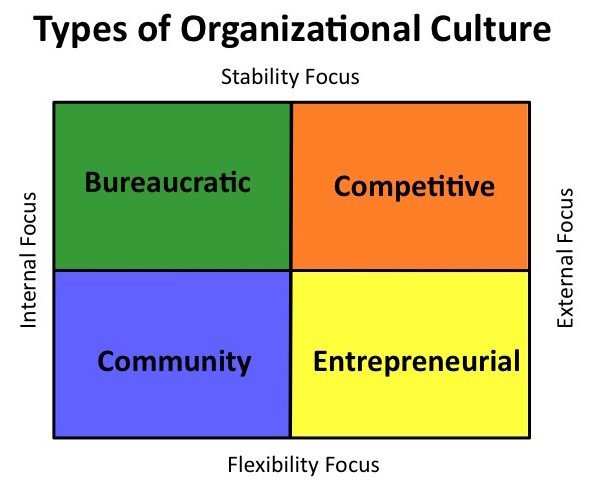Four Types of Organizational Culture
There are many types of organizational culture. Some cultures are fun-loving (Zappos) while others are more staid and rule-bound (Bank of America). Some cultures are caring (Patagonia), while others are cold and impersonal (Best Buy).
Organizational culture arises from the underlying assumptions, values and beliefs that determine how people behave. Culture can be described as the environment or atmosphere, but it’s more than that. You might think of it as an organization’s personality.
Culture drives the organization, and if it is not aligned with the business strategies, it will thwart your organization’s effectiveness. Peter Drucker, the founding father of modern business, is often quoted as having said, “Culture eats strategy for breakfast.”
Quinn & Rohrbaugh created the Competing Values Framework based on their research (1983), which showed two key variables that form four basic types of organizational culture.
1) To what extent the organization’s focus is internal (on employees) vs. external (on customers and the market
2) How much the organization leans toward stability and control or toward flexibility and change.
These two variables show 4 types of organizational culture, depicted on the diagram and described below.
Types of Organizational Culture
Bureaucratic
There is a well-defined, formal, structured work environment that depends on authority, hierarchy and procedures to keep the organization running smoothly. There is a focus on efficiency, reliability and smooth execution.
Goal: Predictability
Identity: Belonging – The organization will take care of you in exchange for loyalty.
Orientation: How things are done –accuracy, efficiency in task completion
Approach to work: Do things right
Leadership style: Authority
Downside: Red tape
Community
This is a friendly environment to work in. People are relationship-oriented and express themselves more openly. There is a high level of involvement and teamwork. A great value is placed on trust and morale, and at times established policies may be disregarded in order to maintain positive relationships.
Goal: Synergy
Identity: Belonging – You are part of a family that cares about you
Orientation: How things are done – teamwork
Approach to work: Do things together
Leadership style: Mentor
Downside: Group think
Competitive
There is a pervasive customer-focused, goal-oriented attitude with a strong emphasis on delivering results. Policies, procedures, and measures are aligned to respond to the demands of the market and meet customer needs. The environment is challenging and competitive. Top performers are rewarded and highly regarded.
Goal: Winning
Identity: Meritocracy
Orientation: Results – winning
Approach to work: Do things best
Leadership style: Coach
Downside: Stress and burnout
Entrepreneurial
There is an entrepreneurial, innovative environment where risk-taking, experimentation and creativity are more important than policies or procedures. Individual initiative and freedom are encouraged. The atmosphere is dynamic and free-wheeling, and roles are not always clearly defined.
Goal: Innovation
Identity: Individual initiative
Orientation: Results – creative new ways to solve problems
Approach to work: Do things differently
Leadership: Emergent (arises in relation to what’s needed)
Downside: Chaos
The Shape of Organizational Culture
Just as each individual’s personality is unique, so is each organization’s culture. Rarely does an organization’s culture lie entirely in one quadrant. For example, this shape would be typical of a tech startup. Free-wheeling, fun-loving, hard-working, creative, and innovative. Lots of mistakes, lots of learning. A strong sense of camaraderie. Think of Apple in its early days.
Over time, as that company matures, the shape of the organizational culture is likely to change. It might start to look more like the diagram below. Still outward focused, but less camaraderie, more focus on individual performance, and less tolerance for mistakes.
However, it might take a different shape, depending on several unpredictable factors such as the values and beliefs of new leaders, effects of disruptive technologies, and changes in regulations or the economy. The older and larger the organization is, the more set its culture becomes.
The Best Type of Organizational Culture
There is no one best culture. The best shape for your culture depends on your business and its goals. What’s important is that your culture and business strategies are aligned.
Monitoring your organization’s culture is as important as monitoring profits. If at some point you find your culture and business strategies are no longer aligned, you will need to think about culture change. When considering change, take a look at the opposite type of culture for clues on what’s needed, instead of dismissing the opposite (ex. collaborative is better than competitive).


